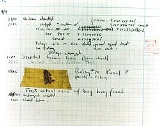
Harvard Mark II
Encyclopedia
The Harvard Mark II was an electromechanical computer built at Harvard University
under the direction of Howard Aiken
and was finished in 1947. It was financed by the United States Navy
.
The Mark II was constructed with high-speed electromagnetic relays instead of electro-mechanical counters used in the Mark I, making it much faster than its predecessor. Its addition time was 125,000 microseconds and the multiplication time was 750,000 microseconds (this was a factor of 2.6 and a factor 8 faster, respectively, compared to the Mark I). It was the second machine (after the Bell Labs Relay Calculator) to have floating-point hardware. A unique feature of the Mark II is that it had built-in hardware for several functions such as the reciprocal, square root, logarithm, exponential, and some trigonometric functions. These took between five and twelve seconds to execute.
The Mark II was not a stored-program computer
– it read an instruction
of the program one at a time from a tape and executed it (like the Mark I). This separation of data and instructions is known as the Harvard architecture
. The Mark II had a peculiar programming method that was devised to ensure that the contents of a register were available when needed. The tape containing the program could encode only eight instructions, so what a particular instruction code meant depended on when it was executed. Each second was divided up into several periods, and a coded instruction could mean different things in different periods. An addition could be started in any of eight periods in the second, a multiplication could be started in any of four periods of the second, and a transfer of data could be started in any of twelve periods of the second. Although this system worked, it made the programming complicated, and it reduced the efficiency of the machine somewhat.
The Mark II ran some realistic test programs in July 1947. It was delivered to the US Navy Proving Ground at Dahlgren, Virginia
in 1947 or 1948.
Harvard University
Harvard University is a private Ivy League university located in Cambridge, Massachusetts, United States, established in 1636 by the Massachusetts legislature. Harvard is the oldest institution of higher learning in the United States and the first corporation chartered in the country...
under the direction of Howard Aiken
Howard Aiken
Howard Hathaway Aiken was a pioneer in computing, being the original conceptual designer behind IBM's Harvard Mark I computer....
and was finished in 1947. It was financed by the United States Navy
United States Navy
The United States Navy is the naval warfare service branch of the United States Armed Forces and one of the seven uniformed services of the United States. The U.S. Navy is the largest in the world; its battle fleet tonnage is greater than that of the next 13 largest navies combined. The U.S...
.
The Mark II was constructed with high-speed electromagnetic relays instead of electro-mechanical counters used in the Mark I, making it much faster than its predecessor. Its addition time was 125,000 microseconds and the multiplication time was 750,000 microseconds (this was a factor of 2.6 and a factor 8 faster, respectively, compared to the Mark I). It was the second machine (after the Bell Labs Relay Calculator) to have floating-point hardware. A unique feature of the Mark II is that it had built-in hardware for several functions such as the reciprocal, square root, logarithm, exponential, and some trigonometric functions. These took between five and twelve seconds to execute.
The Mark II was not a stored-program computer
Stored-program computer
A stored-program computer is one which stores program instructions in electronic memory. Often the definition is extended with the requirement that the treatment of programs and data in memory be interchangeable or uniform....
– it read an instruction
Instruction set
An instruction set, or instruction set architecture , is the part of the computer architecture related to programming, including the native data types, instructions, registers, addressing modes, memory architecture, interrupt and exception handling, and external I/O...
of the program one at a time from a tape and executed it (like the Mark I). This separation of data and instructions is known as the Harvard architecture
Harvard architecture
The Harvard architecture is a computer architecture with physically separate storage and signal pathways for instructions and data. The term originated from the Harvard Mark I relay-based computer, which stored instructions on punched tape and data in electro-mechanical counters...
. The Mark II had a peculiar programming method that was devised to ensure that the contents of a register were available when needed. The tape containing the program could encode only eight instructions, so what a particular instruction code meant depended on when it was executed. Each second was divided up into several periods, and a coded instruction could mean different things in different periods. An addition could be started in any of eight periods in the second, a multiplication could be started in any of four periods of the second, and a transfer of data could be started in any of twelve periods of the second. Although this system worked, it made the programming complicated, and it reduced the efficiency of the machine somewhat.
The Mark II ran some realistic test programs in July 1947. It was delivered to the US Navy Proving Ground at Dahlgren, Virginia
Dahlgren, Virginia
Dahlgren is a census-designated place in King George County, Virginia, United States. The population was 997 at the 2000 census. The community is located within the Northern Neck George Washington Birthplace American Viticultural Area winemaking appellation established by the United States...
in 1947 or 1948.

